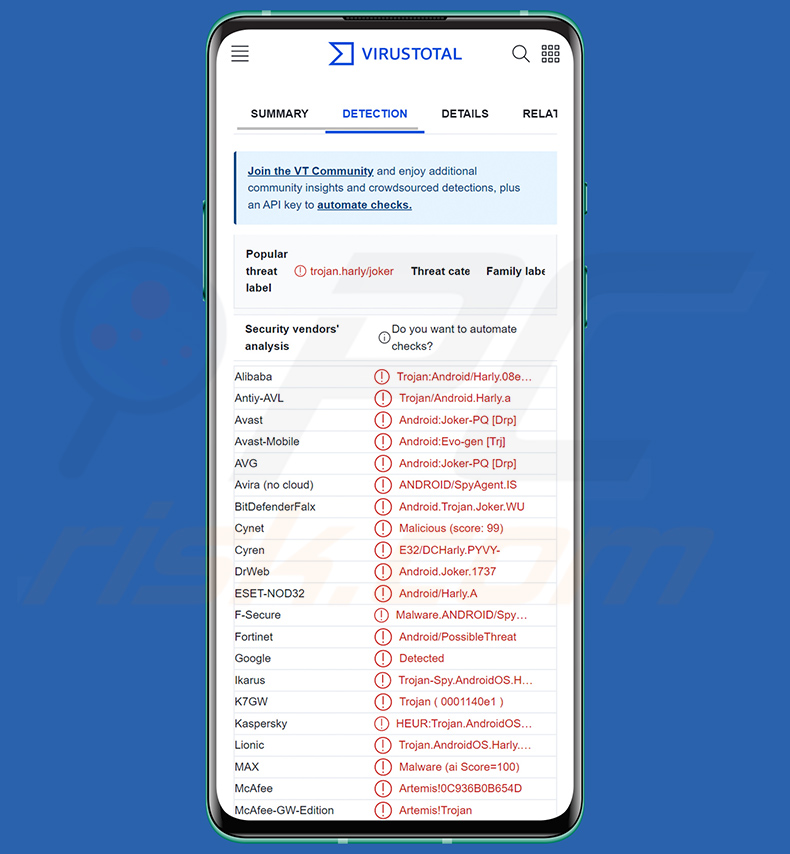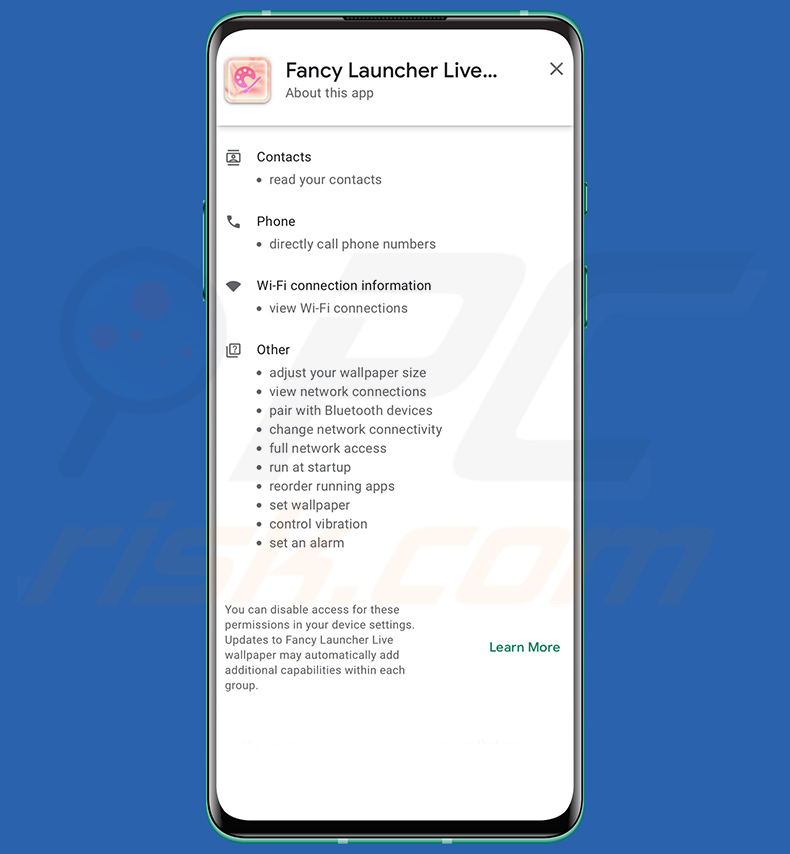Get free scan and check if your device is infected.
Remove it nowTo use full-featured product, you have to purchase a license for Combo Cleaner. Seven days free trial available. Combo Cleaner is owned and operated by RCS LT, the parent company of PCRisk.com.
What is Harly malware?
Harly is a piece of malicious software targeting Android operating systems. It is a type of toll fraud malware designed to stealthily subscribe victims to various premium-rate services. Harly is proliferated under the guise of various useful and innocuous-looking applications.

Harly malware overview
As mentioned in the introduction, Harly infiltrates devices disguised as an ordinary application; a few of these disguises include (but are not limited to): Fancy Launcher Live wallpaper, BinBin Flash, Mondy Gamebox, and Flashlight & More Convenience.
This malware's goal is to subscribe victims to a variety of premium-rate services. Malicious programs of this kind can sign up victims for expensive mobile services, online subscriptions, etc.
By reviewing the permissions requested by Fancy Launcher Live wallpaper (a disguise of Harly), we can conclude that this malware is capable of obtaining victims' contact lists, making phone calls, managing Wi-Fi connections and settings, checking and altering running processes, pairing up with Bluetooth devices, turning device vibration on/off, setting alarms, and changing/adjusting wallpapers.
One of the permissions requested by Harly is automatically running on startup, which is how this malware ensures persistence.
Based on the program's ability to call telephone numbers, it can be used to continuously phone premium-rate numbers. Hence, victims of such toll fraud will constantly receive increased monthly telephone bills until they take action and investigate the cause. Depending on the cyber criminals' modus operandi, the malware may profit by receiving anywhere from one to three digit sums every month from a single victim.
It is noteworthy that malicious software developers often improve upon and update their creations; hence, Harly's functionality list may differ in the future.
To summarize, Harly malware infections can lead to severe privacy issues, significant financial losses, and potentially even identity theft.
If you suspect that your device is infected with this or other malware, we strongly advise you to use an anti-virus and remote the threats without delay. And if you are being billed by suspicious entities - immediately contact your mobile service provider.
| Name | Harly virus |
| Threat Type | Android malware, toll fraud malware, malicious application. |
| Detection Names (Fancy Launcher Live wallpaper) | Avast-Mobile (APK:RepMalware [Trj]), DrWeb (Android.Joker.1737), ESET-NOD32 (Android/Harly.A), Kaspersky (HEUR:Trojan.AndroidOS.Harly.p), Full List (VirusTotal) |
| Detection Names (BinBin Flash) | Avast-Mobile (APK:RepMalware [Trj]), DrWeb (Android.Joker.1738), ESET-NOD32 (Android/Harly.B), Kaspersky (HEUR:Trojan.AndroidOS.Harly.e), Full List (VirusTotal) |
| Symptoms | The device is running slow, system settings are modified without user's permission, questionable applications appear, data and battery usage is increased significantly, browsers redirect to questionable websites, intrusive advertisements are delivered. |
| Distribution methods | Infected email attachments, malicious online advertisements, social engineering, deceptive applications, scam websites. |
| Damage | Stolen personal information (private messages, logins/passwords, etc.), decreased device performance, battery is drained quickly, decreased Internet speed, huge data losses, monetary losses, stolen identity (malicious apps might abuse communication apps). |
| Malware Removal (Windows) |
To eliminate possible malware infections, scan your computer with legitimate antivirus software. Our security researchers recommend using Combo Cleaner. Download Combo CleanerTo use full-featured product, you have to purchase a license for Combo Cleaner. 7 days free trial available. Combo Cleaner is owned and operated by RCS LT, the parent company of PCRisk.com. |
Similar Android-targeting malware examples
We have analyzed dozens of Android-specific malicious programs; GriftHorse and Joker are examples of malware with capabilities similar to Harly.
Malicious software can have a broad range of functionalities, which can be in varied combinations. However, regardless of how malware operates - its presence endangers device integrity and user safety. Therefore, it is crucial to eliminate threats immediately upon detection.
How did Harly infiltrate my device?
Malware is proliferated using phishing and social engineering tactics. Malicious programs are usually presented as or bundled with regular software/media.
Harly has been observed under various disguises, e.g., Fancy Launcher Live wallpaper, BinBin Flash, Mondy Gamebox, Flashlight & More Convenience, etc. Some of these malicious apps were available on the Google Play Store; while these specific names may have already been removed from this legitimate platform, new ones may have appeared in their stead.
It must be mentioned that Harly can be distributed using other methods as well. The most commonly employed malware-spreading techniques include: drive-by (stealthy/deceptive) downloads, online scams, freeware and third-party download websites, P2P sharing networks (Torrent clients, eMule, Gnutella, etc.), malicious attachments/links in spam mail (e.g., emails, SMSes, DMs/PMs, etc.), illegal software activation ("cracking") tools, fake updates, and malvertising.
How to avoid installation of malware?
We highly recommend researching apps prior to download/installation and/or purchase, e.g., by reading terms, inspecting requested permissions, checking out expert and user reviews, verifying developer legitimacy, etc. Additionally, all downloads must be performed from official and trustworthy sources.
It is just as important to activate and update software using legitimate functions/tools, as illegal activation tools ("cracks") and fake updaters may contain malware.
Another recommendation is to be vigilant when browsing since fraudulent and malicious content tends to look ordinary and harmless.
We advise against opening the attachments and links in suspicious/irrelevant emails and messages - as that can result in a system infection. It is paramount to have a dependable anti-virus installed and kept up-to-date. Security programs must be used to run regular system scans and to remove detected threats and issues.
Appearance of the permissions asked by "Fancy Launcher Live wallpaper" - a disguise used by Harly malware:

Appearance of "Mondy Gamebox" (another disguise of Harly malware) promoted on the Google Play Store:

Appearance of "Recipes & Cooking Tools" (another disguise of Harly malware) promoted on the Google Play Store:

Quick menu:
- Introduction
- How to delete browsing history from the Chrome web browser?
- How to disable browser notifications in the Chrome web browser?
- How to reset the Chrome web browser?
- How to delete browsing history from the Firefox web browser?
- How to disable browser notifications in the Firefox web browser?
- How to reset the Firefox web browser?
- How to uninstall potentially unwanted and/or malicious applications?
- How to boot the Android device in "Safe Mode"?
- How to check the battery usage of various applications?
- How to check the data usage of various applications?
- How to install the latest software updates?
- How to reset the system to its default state?
- How to disable applications that have administrator privileges?
Delete browsing history from the Chrome web browser:

Tap the "Menu" button (three dots on the right-upper corner of the screen) and select "History" in the opened dropdown menu.

Tap "Clear browsing data", select "ADVANCED" tab, choose the time range and data types you want to delete and tap "Clear data".
Disable browser notifications in the Chrome web browser:

Tap the "Menu" button (three dots on the right-upper corner of the screen) and select "Settings" in the opened dropdown menu.

Scroll down until you see "Site settings" option and tap it. Scroll down until you see "Notifications" option and tap it.

Find the websites that deliver browser notifications, tap on them and click "Clear & reset". This will remove permissions granted for these websites to deliver notifications. However, once you visit the same site again, it may ask for a permission again. You can choose whether to give these permissions or not (if you choose to decline the website will go to "Blocked" section and will no longer ask you for the permission).
Reset the Chrome web browser:

Go to "Settings", scroll down until you see "Apps" and tap it.

Scroll down until you find "Chrome" application, select it and tap "Storage" option.

Tap "MANAGE STORAGE", then "CLEAR ALL DATA" and confirm the action by taping "OK". Note that resetting the browser will eliminate all data stored within. This means that all saved logins/passwords, browsing history, non-default settings and other data will be deleted. You will also have to re-login into all websites as well.
Delete browsing history from the Firefox web browser:

Tap the "Menu" button (three dots on the right-upper corner of the screen) and select "History" in the opened dropdown menu.

Scroll down until you see "Clear private data" and tap it. Select data types you want to remove and tap "CLEAR DATA".
Disable browser notifications in the Firefox web browser:

Visit the website that is delivering browser notifications, tap the icon displayed on the left of URL bar (the icon will not necessarily be a "Lock") and select "Edit Site Settings".

In the opened pop-up opt-in the "Notifications" option and tap "CLEAR".
Reset the Firefox web browser:

Go to "Settings", scroll down until you see "Apps" and tap it.

Scroll down until you find "Firefox" application, select it and tap "Storage" option.

Tap "CLEAR DATA" and confirm the action by taping "DELETE". Note that resetting the browser will eliminate all data stored within. This means that all saved logins/passwords, browsing history, non-default settings and other data will be deleted. You will also have to re-login into all websites as well.
Uninstall potentially unwanted and/or malicious applications:

Go to "Settings", scroll down until you see "Apps" and tap it.

Scroll down until you see a potentially unwanted and/or malicious application, select it and tap "Uninstall". If, for some reason, you are unable to remove the selected app (e.g., you are prompted with an error message), you should try using the "Safe Mode".
Boot the Android device in "Safe Mode":
The "Safe Mode" in Android operating system temporarily disables all third-party applications from running. Using this mode is a good way to diagnose and solve various issues (e.g., remove malicious applications that prevent users you from doing so when the device is running "normally").

Push the "Power" button and hold it until you see the "Power off" screen. Tap the "Power off" icon and hold it. After a few seconds the "Safe Mode" option will appear and you'll be able run it by restarting the device.
Check the battery usage of various applications:

Go to "Settings", scroll down until you see "Device maintenance" and tap it.

Tap "Battery" and check the usage of each application. Legitimate/genuine applications are designed to use as low energy as possible in order to provide the best user experience and to save power. Therefore, high battery usage may indicate that the application is malicious.
Check the data usage of various applications:

Go to "Settings", scroll down until you see "Connections" and tap it.

Scroll down until you see "Data usage" and select this option. As with battery, legitimate/genuine applications are designed to minimize data usage as much as possible. This means that huge data usage may indicate presence of malicious application. Note that some malicious applications might be designed to operate when the device is connected to wireless network only. For this reason, you should check both Mobile and Wi-Fi data usage.

If you find an application that uses a lot of data even though you never use it, then we strongly advise you to uninstall it as soon as possible.
Install the latest software updates:
Keeping the software up-to-date is a good practice when it comes to device safety. The device manufacturers are continually releasing various security patches and Android updates in order to fix errors and bugs that can be abused by cyber criminals. An outdated system is way more vulnerable, which is why you should always be sure that your device's software is up-to-date.

Go to "Settings", scroll down until you see "Software update" and tap it.

Tap "Download updates manually" and check if there are any updates available. If so, install them immediately. We also recommend to enable the "Download updates automatically" option - it will enable the system to notify you once an update is released and/or install it automatically.
Reset the system to its default state:
Performing a "Factory Reset" is a good way to remove all unwanted applications, restore system's settings to default and clean the device in general. However, you must keep in mind that all data within the device will be deleted, including photos, video/audio files, phone numbers (stored within the device, not the SIM card), SMS messages, and so forth. In other words, the device will be restored to its primal state.
You can also restore the basic system settings and/or simply network settings as well.

Go to "Settings", scroll down until you see "About phone" and tap it.

Scroll down until you see "Reset" and tap it. Now choose the action you want to perform:
"Reset settings" - restore all system settings to default;
"Reset network settings" - restore all network-related settings to default;
"Factory data reset" - reset the entire system and completely delete all stored data;
Disable applications that have administrator privileges:
If a malicious application gets administrator-level privileges it can seriously damage the system. To keep the device as safe as possible you should always check what apps have such privileges and disable the ones that shouldn't.

Go to "Settings", scroll down until you see "Lock screen and security" and tap it.

Scroll down until you see "Other security settings", tap it and then tap "Device admin apps".

Identify applications that should not have administrator privileges, tap them and then tap "DEACTIVATE".
Frequently Asked Questions (FAQ)
My Android device is infected with Harly malware, should I format my storage device to get rid of it?
No, Harly's removal does not necessitate formatting.
What are the biggest issues that Harly malware can cause?
The threats posed by a malicious program depend on its functionalities and the cyber criminals' aims. Harly is designed to stealthily subscribe victims to various premium-rate services. Therefore, the primary threats of these infections include severe privacy issues and significant financial losses.
What is the purpose of Harly malware?
Malware is typically used to generate revenue, and that applies to Harly. However, it is pertinent to mention that malicious software is also used to amuse cyber criminals, carry out personal vendettas, disrupt processes (e.g., websites, services, companies, etc.), and even launch politically/geopolitically motivated attacks.
How did Harly malware infiltrate my Android device?
Harly has been observed disguised as various innocuous-looking apps and promoted on the Google Play Store. However, this malicious software is likely spread using other methods as well. The most popular distribution techniques include: drive-by downloads, spam mail (e.g., emails, SMSes, DMs/PMs, etc.), online scams, untrustworthy download channels (e.g., unofficial and freeware websites, Peer-to-Peer sharing networks, etc.), illegal program activation tools ("cracks"), malvertising, and fake updates.
Share:

Tomas Meskauskas
Expert security researcher, professional malware analyst
I am passionate about computer security and technology. I have an experience of over 10 years working in various companies related to computer technical issue solving and Internet security. I have been working as an author and editor for pcrisk.com since 2010. Follow me on Twitter and LinkedIn to stay informed about the latest online security threats.
PCrisk security portal is brought by a company RCS LT.
Joined forces of security researchers help educate computer users about the latest online security threats. More information about the company RCS LT.
Our malware removal guides are free. However, if you want to support us you can send us a donation.
DonatePCrisk security portal is brought by a company RCS LT.
Joined forces of security researchers help educate computer users about the latest online security threats. More information about the company RCS LT.
Our malware removal guides are free. However, if you want to support us you can send us a donation.
Donate
▼ Show Discussion